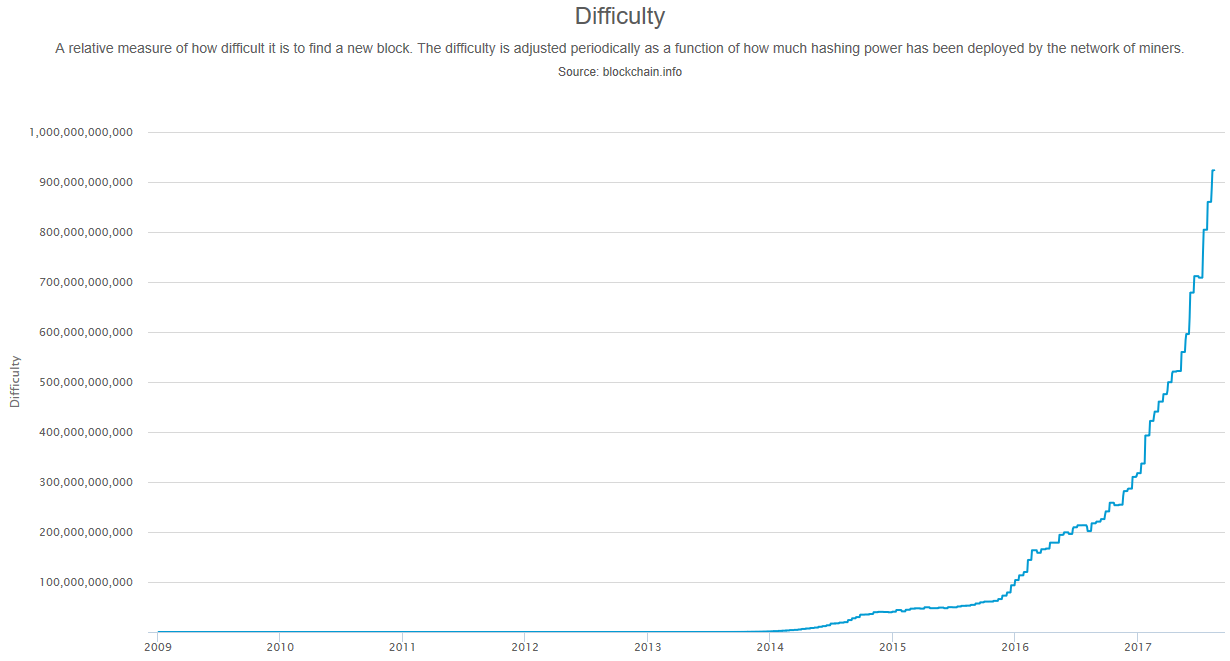There is one more issue that needs to be resolved: how to maintain the new block building rate of 10 minutes. If nothing is done, the mining rate will change due to the following factors:
- The number of miners on the network can vary in response to the BTC price
- Technology advancements make mining rigs progressively faster
- The total number of mining rigs varies
Bitcoin adjusts the difficulty level of the mathematical puzzle in order to keep the building rate at 10 minutes. The difficulty level is calculated from the rate at which the most recent blocks were added in. If the average rate of new blocks being added is less than 10 minutes, the difficulty level will be increased. If the average rate takes more than 10 minutes, it's decreased. The difficulty level is updated every 2,016 blocks. The following graph displays the historical trend in Bitcoin difficulty level.

We have yet to talk about the actual mining algorithm. Assume the current difficulty level is to find the first hash value with the leading character to be 0. In Bitcoin, the process of solving a puzzle, that is, mining, requires a miner to follow these steps:
- First, find the SHA-256 hash of the block in construction.
- If the resulting hash has a leading 0, the miner solves the puzzle. The miner links the block to the ledger on the node and claims the trophy, 12.5 BTCs. The miner's node broadcasts the news to all nodes. All other nodes and miners on the network validate the answer (by mapping the block information plus nonce to get the same hash) and validate the entire history of the ledger, making sure that the block contains valid transactions.
- If it passes the checks, all nodes on the network add the block to their copies of the ledger. Miners start to work on the next new block.
- If the winning miner is a malicious attacker and includes bad transactions in the block, the validation of these transactions will fail and other miners will not include the block in their ledger copies. They will continue to mine on the current block. As time passes, the path containing the bad block will no longer be the longest path and, therefore, the bad block will become an orphaned block. This is essentially how all nodes on the network reach consensus to add only good blocks to the network and prevent bad blocks from sneaking in, therefore resolving the double-spending issue.
- If the resulting hash does not start with 0, then the miner is allowed to append a sequence number, known to be a nonce, starting from 0 to the input text, and retry the hash.
- If the resulting hash still does not contain a leading 0, the miner will add another sequence number, 1, to the input text and obtain a new hash. The miner will keep trying in this way until it finds the first hash with a leading zero.
The following is an example of how the plaintext and nonce work together. The original plaintext is input string and the nonce varies from 0 to 1:
- input string: f23f4781d6814ebe349c6b230c1f700714f4f70f735022bd4b1fb69421859993
- input string0: 5db70bb3ae36e5b87415c1c9399100bc60f2068a2b0ec04536e92ad2598b6bbb
- input string1: 5d0a0f2c69b88343ba44d64168b350ef62ce4e0da73044557bff451fd5df6e96
In Bitcoin, adjusting difficult level largely refers to changing the required number of leading zeros. (The actual adjustment involves some other miner tuning to the requirement.) Each addition of a leading zero will increase the average number of tries significantly and therefore will increase the computing time. This is how Bitcoin manages to maintain the average rate of 10 minutes for new blocks being added in. The current Bitcoin difficulty level is 18 leading zeros.
